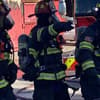Podcast
Questions and Answers
What are evidence-based techniques?
What are evidence-based techniques?
Techniques or practices that are supported by scientific evidence of their safety and efficacy.
What is medical direction in an EMS system?
What is medical direction in an EMS system?
Oversight of the patient-care aspects of an EMS system by the Medical Director.
Who is a Medical Director?
Who is a Medical Director?
A physician who assumes ultimate responsibility for the patient-care aspects of the EMS system.
What is the 911 system?
What is the 911 system?
What is off-line medical direction?
What is off-line medical direction?
What is on-line medical direction?
What is on-line medical direction?
What are patient outcomes?
What are patient outcomes?
What does peer reviewed mean?
What does peer reviewed mean?
What are protocols in an EMS system?
What are protocols in an EMS system?
What is quality improvement?
What is quality improvement?
What are standing orders?
What are standing orders?
What are the National Highway Traffic Safety Administration (NHTSA) Technical Assistance Program standards?
What are the National Highway Traffic Safety Administration (NHTSA) Technical Assistance Program standards?
What are the Levels of EMS Training?
What are the Levels of EMS Training?
What are some Specialty Centers in hospitals that EMTs should know?
What are some Specialty Centers in hospitals that EMTs should know?
What are the components of the EMS system?
What are the components of the EMS system?
What important training should EMDs go through?
What important training should EMDs go through?
What are the roles and responsibilities of EMTs?
What are the roles and responsibilities of EMTs?
What are the specific areas of responsibility for an EMT?
What are the specific areas of responsibility for an EMT?
What are good physical traits that an EMT should have?
What are good physical traits that an EMT should have?
Flashcards are hidden until you start studying
Study Notes
Evidence-Based Techniques
- Techniques supported by scientific evidence for safety and efficacy.
- Emphasis on practices over tradition and supposition.
Medical Direction
- Oversight of EMS patient care by a Medical Director.
- Can include off-line (standing orders) or on-line (real-time communication) direction.
Medical Director
- Physician responsible for the patient-care aspects within the EMS system.
911 System
- A system for reporting emergencies via telephone.
- Dispatchers coordinate response, alerting necessary services such as EMS, fire, or police.
Off-Line Medical Direction
- Standing orders from the Medical Director for EMTs to administer certain medications or procedures without immediate consultation.
On-Line Medical Direction
- Direct orders communicated to EMTs in the field through radio or telephone by an on-duty physician.
Patient Outcomes
- Focused on the long-term survival and health status of patients after receiving care.
Peer Reviewed
- Research submitted to professional journals and evaluated by experts in the field for validity and reliability.
Protocols
- Step-by-step procedures for assessments and interventions in various emergency situations.
Quality Improvement
- Ongoing self-review process aimed at identifying and rectifying areas needing improvement within the EMS system.
Standing Orders
- Policies issued by a Medical Director allowing EMTs to perform specific skills under defined conditions.
NHTSA Technical Assistance Program Standards
- Cover regulations and policy, resource management, human resources and training, transportation, facilities, communications, public education, medical directions, trauma systems, and evaluation.
Levels of EMS Training
- EMR (Emergency Medical Responder)
- EMT (Emergency Medical Technician)
- AEMT (Advanced Emergency Medical Technician)
- Paramedic
Specialty Centers in Hospitals
- Trauma Centers
- Burn Centers
- Pediatric Centers
- Cardiac Centers
- Stroke Centers
Components of the EMS System
- Initiates with the Emergency Medical Dispatcher (EMD) receiving a 911 call.
- EMS sends responders to the site, transports patients to the hospital, and ensures continuity of care in the emergency department.
Important Training for EMDs
- Training should include CPR, artificial ventilation, and bleeding control for effective emergency response.
Roles and Responsibilities of EMTs
- Preparation for emergencies.
- Ensure safe scene response and transportation.
- Transition care to hospital personnel.
Specific Areas of Responsibility for EMTs
- Personal safety and teamwork with public safety professionals.
- Patient care, lifting and moving patients, transport, transfer of care, and advocacy.
Good Physical Traits for EMTs
- Physical fitness, good eyesight, color vision, and strong listening and communication skills are essential.
Studying That Suits You
Use AI to generate personalized quizzes and flashcards to suit your learning preferences.





